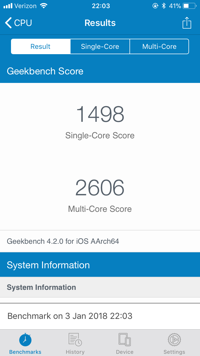Introduction
Recently, I have been following the apple battery throttling scandal that started with a Reddit post and subsequently a formal analysis by GeekBench author John Poole which led me to wonder if the poor performance I've experienced on my iPhone 6 since last year could be related to it. My iPhone 6 was purchased in December 2014 and has been my workhorse for over three years. I never felt the need to upgrade until recently due to it offering all the features I use on a daily basis including Apple Pay, a decent camera, and common tasks such as email and messages. Not much has changed regarding features that I desire; however, one critical thing that began to bother me and compel me to upgrade was the consistent lag on the device. Once seamless tasks such as opening Mail or responding to multiple message chains on Messages while browsing the web slowed to a crawl within the past six months.
Fast forward to the December 2017 revelation of what some on Twitter are calling #ThrottleGate which subsequently led to Apple issuing a formal response; I decided to take matters into my own hands. I had already replaced the screen on my device earlier in 2017 due to an accidental fall out of my pocket, and therefore, I wouldn't be eligible for the discounted $29 apple battery replacement. I went for the next best option. After some research on Reddit and various other internet sources, IFixIt.com seemed to have a reputation for offering close to OEM standard battery replacements for iPhones.
Pre-Replacement Capacity and Benchmark
The battery I ordered was delivered within seven days, and I began the process of preparing to replace it. My first step was to analyze data from the original Apple battery using a free tool called coconutBattery. The results (screenshot below) showed that my battery could only deliver roughly 85.3% of its original design capacity and has over 1100 charge cycles recorded. The second step I took was to run the iOS Geekbench CPU benchmark to confirm my suspicions on whether or not my device's CPU (Apple A8) was in-fact being throttled. The results (screenshot below) showed a single core score of 1315 and a multi-core score of 2235.


Post-Replacement Capacity and Benchmark
Using the iFixIt guide I was able to replace the battery within roughly an hour. I found the most difficult part of the repair to be aligning the new battery connector likec the OEM battery. The replacement battery comes in an "unfolded" state and therefore, I would suggest prior to placing the battery onto the adhesive in the case, manipulating the battery cable into a folded state similar to the OEM battery- this will make your installation easier. After the phone booted up, I re-ran the Geekbench iOS benchmark and tested the battery using coconutBattery as I did prior. The geekbench results showed a single core score of 1498 (~13.9% improvement) and a multi-core score of 2606 (~16.5% improvement).


Conclusion
After two days of continuous use of the iPhone 6 with the new battery, I am happy to report that my phone is back to the level of operating performance I experienced when I originally purchased the phone. I no longer experience stuttering or user interface latency when I am multitasking or even doing simple tasks such as responding to text messages. If you have an iPhone 6S or below and are considering purchasing a new phone due to lag, I would highly suggest investigating the state of your battery before doing so. It may save you a few dollars and allow you to hold out a bit longer before upgrading.